According to the Hindustan Times ( December 2, 2008), the LeT’s name as the main plotter of a sea-borne terrorist strike in Mumbai directed against some sea front hotels figured in three technical intelligence reports of the Research & Analysis Wing (R&AW) based on intercepts reportedly of September 18, September 24 and November 19, 2008. These reports were more specific than the earlier interrogation reports about terrorist strikes planned in Goa.
Also read: 26/11: Pak Army Irregulars attack Mumbai:I
However, whereas the reports relating to Goa spoke specifically of Israeli and Western tourists as the targets, the R&AW reports, while indicating that the sea-side hotels in Mumbai preferred by foreign tourists would be the targets, did not speak specifically of Israeli and Western tourists. Nor was there any reference to a planned terrorist strike in Narriman House. Among the hotels reportedly mentioned by the R&AW was the Taj Mahal Hotel.
The terrorists did not appear to have been interested in taking the Jewish people as hostages and using them to achieve any demand. They just wanted to torture and kill all those found in the premises.
The presence of the Jewish centre in the Narriman House was not very well known in Mumbai outside Jewish circles. The fact that the terrorists had come to know about it and had included it as one of their principal targets spoke of their extensive local knowledge and of the enquiries that must have been made by them about Israeli/Jewish offices and places of stay near the sea front. They must have made detailed local enquiries either during an advance visit or through accomplices in the local Muslim community. The knowledge, which they seem to have had about the Narriman House, definitely spoke of some local involvement at least in intelligence collection.
Mark Sofer, the Israeli Ambassador to India, was quoted as saying: “Out of the thousands of buildings in Mumbai, it was hard to believe that the terrorists had stumbled by chance upon the Jewish center.” They did not target the local Israeli Consulate.
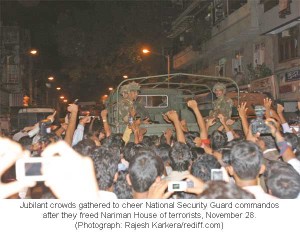 They wanted to kill as many Jewish people as possible and this might not have been possible in the five-star hotels because most Israeli tourists come on a shoe-string budget and stay in cheap hotels away from the sea front. The Narriman House provided a point where many Jewish people — locals, Israelis and Jewish visitors from other countries — congregate. However, since they attacked the place around 10 pm, not many Israelis and other Jewish people were present there. They were able to get only six Jewish people living or temporarily staying in the premises.
They wanted to kill as many Jewish people as possible and this might not have been possible in the five-star hotels because most Israeli tourists come on a shoe-string budget and stay in cheap hotels away from the sea front. The Narriman House provided a point where many Jewish people — locals, Israelis and Jewish visitors from other countries — congregate. However, since they attacked the place around 10 pm, not many Israelis and other Jewish people were present there. They were able to get only six Jewish people living or temporarily staying in the premises.
The terrorists did not appear to have been interested in taking the Jewish people as hostages and using them to achieve any demand. They just wanted to torture and kill all those found in the premises. A rapid reaction raid into the House might have saved at least some lives, if not all the lives. Shortly after getting information about the forcible entry of two terrorists into the Narriman House, a small police party reportedly reached the scene, but it did not apparently have either the numbers or the capability for immediate intervention. One had to wait for the arrival of the specially-trained National Security Guards (NSGs), which is a special intervention force. It arrived the next morning and took nearly 40 hours to enter the premises. By the time it could force its entry into the building it was late. All the six Jewish people had been killed by the terrorists after torturing them. Only an Indian maid managed to escape with a two-year-old Jewish child. While the Israeli authorities have praised the role of the Indian security forces in dealing with the situation and the co-operation extended by the Government of India, a note of regret over the delayed intervention was evident in some of their remarks.
While acknowledging the complexity of ending the attacks across sprawling Mumbai, Ehud Barak, the Israeli Defence Minister, told an Israeli TV channel on November 28: “I’m not sure it had to last three days, but that’s what happened.” Barak told Channel 1 Television that the bodies of two women and three men had been found at the religious-cum-cultural centre. The body of a third woman was found later in the building. Barak added that some of the bodies had been tied up, and that two women had been killed many hours before. “All in all, it was a difficult spectacle,” he said.
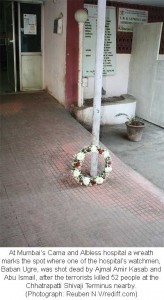 The Defense Minister said that the roots of the attack were in India, but involved militants in Pakistan and Afghanistan. While he did not elaborate, his comments seemed to indicate that the Israeli authorities suspected that it must have been a joint operation of jihadis of India, Pakistan and Afghanistan and not just Pakistan as claimed by India.
The Defense Minister said that the roots of the attack were in India, but involved militants in Pakistan and Afghanistan. While he did not elaborate, his comments seemed to indicate that the Israeli authorities suspected that it must have been a joint operation of jihadis of India, Pakistan and Afghanistan and not just Pakistan as claimed by India.
One could discern notes of criticism in the comments of retired security experts and other private experts too. A former head of Israel’s Mossad external intelligence agency, Danny Yatom, said the attacks revealed major failings in Indian intelligence as they “involved dozens of terrorists enjoying the support of numerous sympathizers.” “It is vital that the Indian security services draw the necessary lessons,” Yatom told a local radio station.
The head of Israel’s counter-terrorism department, Colonel Nitzan Nurieli, said: “We have to acknowledge that in the Mumbai case our intelligence services did not have adequate advance knowledge; nor did the Indian security services.” He urged Israeli tourists to avoid travel to northern India.
Ms Tzipi Livni, the Israeli Foreign Minister said: “There is no doubt, we know, that the targets the terrorists singled out were Jewish, Israeli targets and targets identified with the West, Americans and Britons. Our world is under attack, it doesn’t matter whether it happens in India or somewhere else. There are Islamic extremists who don’t accept our existence or Western values.”
Israeli counter-terrorism experts compared the Mumbai strike to an attempted sea-borne terrorist strike in Tel Aviv in April 2003, when two British Muslims of Pakistani origin, were allegedly recruited by Al Qaeda, to land by sea in Tel Aviv, seize a large beachside hotel and the nearby US embassy, take hostages and shoot as many as possible. Recruited at London’s radical Finsbury Park mosque (like Shoe-bomber Richard Reid) Asif Muhammed Hanif and Omar Khan Sharif were trained in Syria and the Gaza Strip.
Aziz clearly said that the Army shot down the Indian aircraft and asked the HM to claim responsibility. Musharraf replied: “Very good.”
After the Mombasa attack on Israeli tourists by Al Qaeda in November, 2002, in which 13 Israelis were killed, this was the second most devastating attack on Jewish people outside Israel since 9/11. Some Israeli analysts compared the deliberate attack on Jewish people in Mumbai to the attack on the Israeli athletes at the time of the Munich Olympics in 1972. It was even alleged that the terrorist attack on the Jewish people in Mumbai was handled as incompetently by the Indian counter-terrorism machinery as the attack on the Israelis in Munich was handled by the then West German counter-terrorism machinery. There were allegations of Indian arrogance — which was compared to the alleged West German arrogance — in reportedly declining to accept Israeli offers of assistance in terminating the terrorism situation in the Narriman House.
Foreign, including Israeli analysts, seemed to have difficulty in accepting the Indian version that only 10 terrorists were involved and that there was no local involvement. Their view was that an operation of this type could not have been carried out by just 10 terrorists and that too without local help. A widespread impression was that in their anxiety to focus on the LeT involvement, Indian investigators might be missing vital clues about an Al Qaeda hand which would be necessary to prevent a repeat of November 26.
While the modus operandi of terrorists coming stealthily by sea and taking the security forces by surprise had been seen in the past in Sri Lanka and Israel, a new MO seen for the first time in Mumbai was what some Israeli experts described as the human cluster bomb tactics. In a cluster bomb, a number of bombets separate from a mother bomb and spread in different directions killing or maiming people in their path.
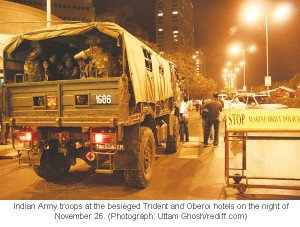 Ten terrorists reached Mumbai, split into four groups and spread in different directions. Two terrorists went round the areas close to the sea front and killed people indiscriminately through hand-held weapons. One of them was killed and another captured — but not before they had killed at least about 70 innocent civilians.
Ten terrorists reached Mumbai, split into four groups and spread in different directions. Two terrorists went round the areas close to the sea front and killed people indiscriminately through hand-held weapons. One of them was killed and another captured — but not before they had killed at least about 70 innocent civilians.
A task of this group apparently was to keep the police preoccupied in hunting for them and to prevent it from going to the main scenes of attack, which had a strategic significance. These were the Taj Mahal Hotel, the Oberoi and Trident hotels, belonging to the same management and located side by side, and the Narriman House.
The delayed response of the NSG and the failure of the local authorities to keep the media out of the scenes of confrontation by imposing a curfew, if necessary, or, at least, by switching off all TV transmissions till the operation was over resulted in three consequences.
Firstly, despite the outstanding bravery of the Police and NSG officers, the credibility of India’s rapid response mechanism was damaged in the eyes of the Indian public and international opinion. Secondly, the TV transmissions even as the confrontation was going on enabled the terrorists to find out what was going on outside without the intervention forces being able to find out what was going on inside. The TV channels unwittingly provided an asymmetric operational advantage to the terrorists. Thirdly, the terrorists received a colossal supply of oxygen in the form of publicity, which could increase the flow of volunteers for more terrorist strikes in future.
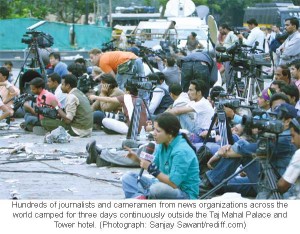 It was evident the terrorist strike had three strategic objectives: firstly, to discredit the Indian political leadership and counter-terrorism apparatus. Secondly, to damage our tourist economy and to create nervousness in the minds of foreign investors about the security of life and property in India. Thirdly, to disrupt the strategic co-operation between India and Israel.
It was evident the terrorist strike had three strategic objectives: firstly, to discredit the Indian political leadership and counter-terrorism apparatus. Secondly, to damage our tourist economy and to create nervousness in the minds of foreign investors about the security of life and property in India. Thirdly, to disrupt the strategic co-operation between India and Israel.
The investigation by the Mumbai Police, assisted by the Intelligence Bureau (IB) and the Research & Analysis Wing (R&AW), had a three-point focus: the role of the LeT and any others involved; the role of the ISI; and a reconstruction of the entire strike.
One got the impression that while the first two received adequate attention, the third did not receive the immediate attention it deserved. Without a satisfactory reconstruction, our ability to prevent a repetition of Mumbai — November 26 in other cities would be weak.
The Mumbai Police and the Maharashtra Government continue to assert, on the basis of the interrogation of the arrested perpetrator that only 10 terrorists were involved. The operation involved detailed intelligence collection, reconnoitering the places to be attacked and the final planning and execution. It is difficult to accept that the same 10 persons performed all these tasks. There definitely must have been more people involved in the conspiracy on the ground in India, in addition to the Pakistan-based conspirators mentioned in the final investigation report of the police — at least performing peripheral roles such as intelligence collection and reconnoitering.
Jihadi terrorists indulge in acts of collective brutality and individualized brutality. The collective brutality is in the form of planting improvised explosive devices (IEDs) in public places, throwing hand-grenades into crowds, etc. There is no face-to-face brutalization. Individualized brutality is face-to-face brutalization of targeted individuals. We had in the past seen instances of individualized brutality in J&K, but not in Indian territory outside J&K. There were many reports from Mumbai of individualized face-to-face brutality against Indian and Israeli nationals and other Jews.
It is very difficult to carry out an operation of this nature by a group of Pakistanis without at least the logistic support of some Indian Muslims.
An organization called the Deccan Mujahideen (DM) was reported to have claimed responsibility in a message sent to the Indian media. Some reports said this message had originated from a computer in Pakistan. The word Deccan refers to South India and was widely used during the British rule. It is now rarely used in India, but in Pakistan it continues to be used widely. Many Pakistanis refer to the Indian Hyderabad as Hyderabad, Deccan, to distinguish it from Hyderabad in Sindh.
After independence in 1947, the ruler of the state of Hyderabad, who was known as the Nizam of Hyderabad, and the ruler of the State of Junagadh in Gujarat, who was known as the Nawab of Junagadh, hesitated to join the Indian Union. Jawaharlal Nehru, the then Prime Minister, sent the Army into Hyderabad to merge it with India. Junagadh also joined India without the need for using the Army there. Many pro-Pakistan Muslims from Hyderabad fled to Karachi and settled down there.
 The LeT has long enjoyed some support from the descendents of some Muslims who migrated to Karachi from Hyderabad and Junagadh. It describes Hyderabad and Junagadh as Pakistani territory illegally occupied by India. One of its objectives is to liberate J&K, Hyderabad and Junagadh from what it describes as Hindu rule. It is possible that some of these Muslims originating from Hyderabad were constituted by the LeT into an organization called the Deccan Mujahideen and told to claim responsibility for the Mumbai terrorist strike. The ISI and the LeT are known to adopt this MO of asking someone else to claim responsibility in order to conceal their own involvement.
The LeT has long enjoyed some support from the descendents of some Muslims who migrated to Karachi from Hyderabad and Junagadh. It describes Hyderabad and Junagadh as Pakistani territory illegally occupied by India. One of its objectives is to liberate J&K, Hyderabad and Junagadh from what it describes as Hindu rule. It is possible that some of these Muslims originating from Hyderabad were constituted by the LeT into an organization called the Deccan Mujahideen and told to claim responsibility for the Mumbai terrorist strike. The ISI and the LeT are known to adopt this MO of asking someone else to claim responsibility in order to conceal their own involvement.
During the Kargil conflict of 1999, the Pakistani Army shot down a plane of the Indian Air Force. The Hizbul Mujahideen (HM), an Indian terrorist organization whose leader Syed Salahuddin is based in Pakistan, claimed responsibility for the shooting. Subsequently, the R&AW intercepted a telephone conversation between Lt.Gen. Mohammad Aziz, the then Chief of the General Staff (CGS), and Musharraf, who was then in Beijing. In that tape, which was released by the Government to the media, Aziz clearly said that the Army shot down the Indian aircraft and asked the HM to claim responsibility. Musharraf replied: “Very good.”
It is very difficult to carry out an operation of this nature by a group of Pakistanis without at least the logistic support of some Indian Muslims. India’s home-grown jihadis fall into two groups.
The first group consists of those who have joined the LeT and the HUJI and have been helping them. These are the fifth columnists in the Indian Muslim community. The second group consists of those calling themselves the Indian Mujahideen (IM), who maintain they have no links with the ISI or the Pakistani jihadi organizations. The IM was responsible for the serial explosions in many cities since November 2007. It also claimed responsibility for the Mumbai suburban train blasts of July, 2006. There was no evidence to show that the IM might have been involved in the 26/11 terrorist strike. The involvement of the group of fifth columnists is a strong likelihood.
The Mumbai Police’s conclusion was that only two Indian Muslims — Faheem Mohammad Ansari and Sabauddin Ahmed — were involved in collecting topographical information long before the terrorist strike. Vital information such as the stay of some Jewish people in the Narriman House and about the fact that the Taj Mahal Hotel had little security at the back entrance through which the terrorists reportedly entered did not appear to have come from these two Indian Muslims. This information could not have been collected through the Internet. How did the LeT get such operationally vital information? It could have got it only from some local accomplices or by a previous visit to Mumbai for local enquiries.
In a telephonic message to the British Broadcasting Corporation (BBC) in the second week of February, 2009, Mustafa Abu-al Yazid, who has been projected since 2007 as in charge of Al Qaeda operations in Afghanistan in liaison with the Neo Taliban of Mulla Mohammad Omar, warned India in the following words: “We send a short and succinct message to the Indian Government.
The Mujahideen will never allow you to invade the Muslims and their lands in Pakistan. If you beguile yourselves into doing this, know well that you will pay a very heavy price, which you will regret much. We will call upon our whole Muslim nation, its Mujahideen and its martyrdom squads against you. We will strike your interests and your economic lifelines wherever they may be until you are demolished and bankrupt as America is being demolished and going bankrupt today.
The Islamic nation which produced the audacious and heroic martyrs of Bombay, who struck you in the midst of your homes and humiliated you, is able to produce thousands more like them. You cannot be more powerful or have more ability than the Soviet Union which was destroyed on the rocks of the Afghanistan mountains nor Americans whose nose we rubbed in the dirt of Afghanistan, Iraq and Somalia.” The authenticity of the message could not be established.
In one’s anxiety to get as much information as possible from the captured terrorist, one did not seem to have paid attention to the important aspect of debriefing all the foreign survivors in the two hotels attacked as to what exactly happened. All of them, after their release, immediately went back to their respective countries .We do not have their version of what happened inside the hotels.
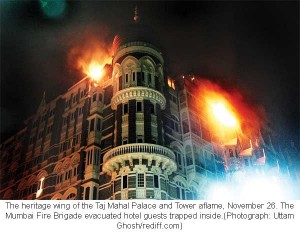 The inadequacies of our intelligence and investigating agencies and of the legal infrastructure against terrorism were known earlier. The startling new revelation was the inadequacies in our physical security apparatus, which made the terrorist strike possible and in our rapid response mechanism, which was brought out by the long time taken to terminate the terrorism situation.
The inadequacies of our intelligence and investigating agencies and of the legal infrastructure against terrorism were known earlier. The startling new revelation was the inadequacies in our physical security apparatus, which made the terrorist strike possible and in our rapid response mechanism, which was brought out by the long time taken to terminate the terrorism situation.
Mumbai is our economic capital. The corporate headquarters of many leading — Indian and foreign — companies are located there. Many of our sensitive establishments, such as the Bombay High off-shore oil installations and some nuclear establishments are also located there. One would have, therefore, expected that our physical security infrastructure in Mumbai would have been the strongest. Instead it was found to have been very weak and was unable to deny success to the terrorists despite the availability of advance intelligence about the LeT’s plans for a sea-borne act of terrorism. If it was so weak in Mumbai, one had reasons to be worried regarding the shape of the physical security infrastructure in other cities.
The terrorist strike and its sequel brought out the totally disjointed manner in which our entire counter-terrorism machinery — the intelligence agencies, the Armed Forces, particularly the Navy, the Police, the National Security Guards, the National Security Council Secretariat (NSG) and the Joint Intelligence Committee — were functioning without any synergy in thinking or action. While the poor reflexes of the Police in dealing with terrorism were known earlier and had been crying for attention for many years, the poor reflexes of the Navy — particularly on the West Coast, which is the most vulnerable to terrorist attacks by sea — were a matter of concern. After 9/11, we have been holding joint counter-terrorism exercises with many countries, including China. No such exercise seemed to have been held among the various agencies of our counter-terrorism community in order to test periodically their ability to act jointly in specific situations.
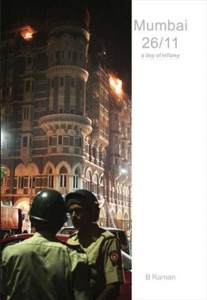 Our counter-terrorism strategy is a fits and starts strategy. In our preoccupation with handling the sequel to the Mumbai strike, we should not lose sight of the investigation into the serial blasts in Uttar Pradesh, Jaipur, Bangalore, Ahmedabad and Delhi, which involved home-grown jihadis. There is very little progress in identifying the command and control of the so-called Indian Mujahideen (IM) and in taking action to neutralize it. The threat posed by the home-grown jihadis has not diminished. On the contrary, it could increase further due to copy-cat effects of Mumbai.
Our counter-terrorism strategy is a fits and starts strategy. In our preoccupation with handling the sequel to the Mumbai strike, we should not lose sight of the investigation into the serial blasts in Uttar Pradesh, Jaipur, Bangalore, Ahmedabad and Delhi, which involved home-grown jihadis. There is very little progress in identifying the command and control of the so-called Indian Mujahideen (IM) and in taking action to neutralize it. The threat posed by the home-grown jihadis has not diminished. On the contrary, it could increase further due to copy-cat effects of Mumbai.




